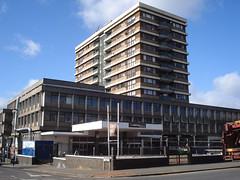Set back from London Road just to the north of Zodiac Court is a low, two-storey block housing a number of small businesses, behind which is a large, currently vacant, nightclub space.
The nightclub space — 169 London Road — and the seven shop units of 171–183 London Road were built in the 1960s as part of the same development that created Zodiac Court, on the site of an older property called Chatfield House. In this article, I’ll discuss the history of Chatfield House and 169 London Road, and in the next, I’ll cover the seven shop units.
1890s: The creation of Chatfield House
As described in part 2 of my mini-series on the Zodiac Court site, Chatfield House was originally part of Broad Green House, which itself had occupied the site since at least the early 1800s. Surrounded by extensive grounds, Broad Green House was home to a succession of well-to-do local residents throughout the 19th century.
After the last of these — Mary Chatfield — died in 1891, the estate was sold off and broken up for housing development. The “grand old house” itself was split into two: the southern half kept the name of Broad Green House, while the northern half became known as Chatfield House. The subsequent story of the former has already been told in the above-linked article, and that of the latter is covered below.
1890s: John and Sarah Pelton
The first inhabitants of the newly-cleaved-off Chatfield House were John and Sarah Pelton. John had traded as a grocer on the High Street since the early 1850s, when as a young man in his early 20s he took over the grocery shop formerly run by John Keates. He and Sarah married around the same time.[1]
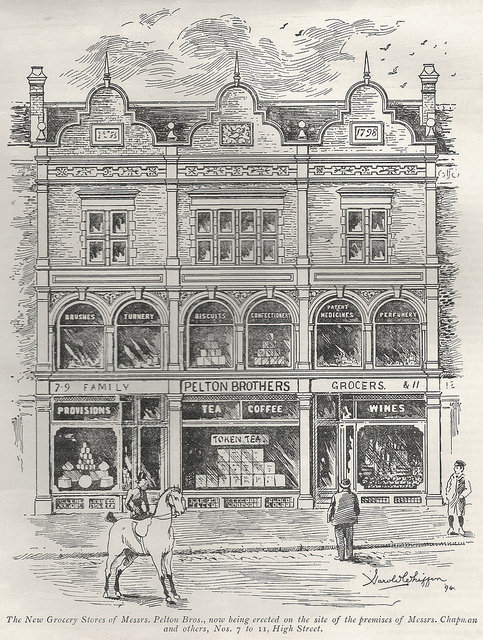
By 1881, John’s grocery business had expanded to three full shopfronts employing a total of 17 men and 4 boys, and around 1888 he opened a new branch called Whitgift Stores at 18 George Street.[2]
John was also active in local politics. He was elected to the Croydon Local Board of Health in 1873, and served until 1877. When the Local Board of Health was replaced by the County Borough of Croydon in 1883, he was again elected to its council, and continued to serve in this capacity for the rest of his life. He became a Justice of the Peace in 1886, and an alderman in 1892.[3]
Local politics and groceries were not the only matters John became involved with; land investment was another of his interests. He was an auditor of the Croydon Permanent Building Society, and Chairman of the Croydon Land and Investment Company. He may, in fact, have been acting on behalf of the latter company when he bought the old Broad Green Estate after the death of Mary Chatfield in 1891; he certainly made a fast profit on this purchase, since he sold his contract with the seller to Sydney Edridge the very same day, gaining £500 in the process (£58,298 in 2016 prices).[4]
It’s unclear whether, at the time of this purchase and sale, John had had any thoughts of moving into Broad Green House himself. He may well have admired the “grand old house”, but perhaps considered it too big for him and Sarah alone. If so, he must have been pleased when Levi Young, who bought the house from Sydney, split it into two properties and offered the Chatfield House half for sale. He and Sarah moved in by the end of 1892.[5]
John died at home on 24 April 1896, at the age of 68. Sarah continued to live at Chatfield House for a couple of years after her husband’s death, but by early 1901 had moved to 108 Oakfield Road, where she in turn died on 8 August 1906.[6]
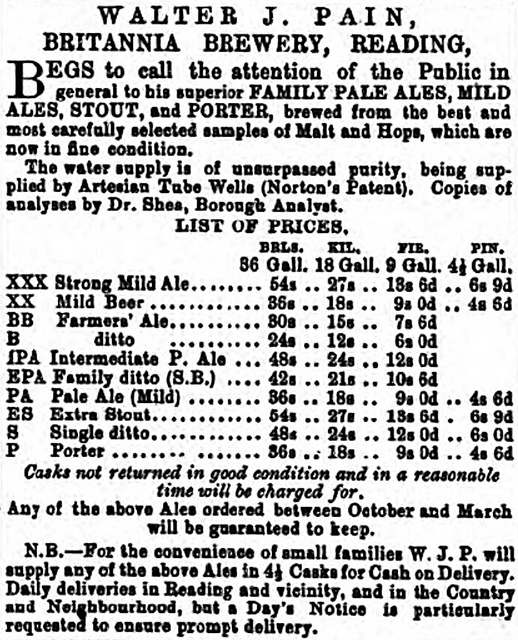
1900s: Walter Julian Pain
Next to move in to Chatfield House were retired brewer Walter Julian Pain, his wife Agnes, and their sons Dalton and Greville.[7]
Walter was born in Nutfield, Surrey, in the late 1840s, to a well-to-do family living in the locally-prominent residence known as Kentwyns. This house dated back to the 1400s, and had been owned by Walter’s ancestors since 1551.[8]
By 1871, Walter had taken up the profession of brewing, but was temporarily unemployed and living with his mother and stepfather on Croydon High Street. By the end of the decade, however, he was running the Britannia Brewery in Reading, offering “superior family pale ales, mild ales, stout, and porter, brewed from the best and most carefully selected samples of Malt and Hops”.[9]
Walter, Agnes, and their sons moved in to Chatfield House around 1899, and promptly renamed it to “Telugu”. It’s not clear why they did this — presumably the name refers to the Telugu people of India, but I’ve been unable to find any Indian connection for the family. In any case, the Pains remained on London Road for only around 8 years, and were gone by early 1908; the name “Telugu” seems to have departed with them.[10]
1900s–1920s: Robert Charles Brown, physician and surgeon
The Pains were replaced by Robert Charles Brown, his wife Sara, and his step-daughter Doris Margaret Hubbard, who had previously lived just down the road at number 145.[11]
Robert was the nephew and namesake of Sir Robert Charles Brown, a Preston surgeon who both worked at and made large financial contributions to the Preston Royal Infirmary, was made Honorary Freeman of the Borough by Preston Council, and was eventually knighted.[12] Our Robert was also a surgeon and physician, having gained his medical degrees at Selwyn College, Cambridge, in 1893. He was practising at 145 London Road by 1904, moved to the erstwhile Chatfield House by 1908, and remained here until his death on 17 June 1924.[13]
1920s–1940s: Valentine Wilkinson, physician and surgeon
Next to arrive was another physician, Valentine Wilkinson. Born in Streatham in 1892, Valentine was forced to interrupt his undergraduate career at Christ’s College, Cambridge, in order to serve in the First World War, gaining the Military Cross in 1918. He married in 1923 and arrived on London Road by 1925, where he remained until the late 1940s before relocating to Sydenham Road. In 1936 he was appointed as certifying surgeon for the factories and workshops of Croydon and surrounds, and he also served as medical officer at the Industrial Rehabilitation Unit at Waddon. He was awarded an OBE in 1962.[14]
1950s–1960s: United Friendly
Valentine’s departure also saw a significant departure from the previous uses of the building. Rather than another private resident, or even a practising doctor, the next occupant was an insurance company known as United Friendly.
Founded by Edwin Balding in 1908 as a general insurance company, United Friendly began with only seven staff and 50 shareholders including “a hop factor, a clerk, a pork butcher, a steamship broker, an auctioneer and a couple of licensed victuallers”. However, growth was rapid. The company took £2,851 in premiums in its first year (£315,000 in 2016 prices), and by 1915 this figure had risen to £18,866 (£1.8m in 2016 prices). It began offering life insurance in 1919.[15]
By 1939 it had “an office in every city and major town”, and by the time it arrived on London Road in the early 1950s it had at least 27 branches in and around London alone. However, along with Broad Green College (its then-neighbour at Broad Green House) it was forced to leave a decade later due to the impending redevelopment of the land. By late 1964, Chatfield House and Broad Green House had been demolished, and work on Zodiac Court had begun.[16]
1960s-1970s: Top Rank
The Zodiac Court development was an ambitious project: large and diverse, including housing, offices, shops, a car showroom and petrol garage, underground parking, and “one of the biggest ballrooms in the South of England”. This ballroom was set out over two floors, with a total area of 36,000 square feet (3,345 square metres), and included bars and a restaurant.[17]
By late 1966, the development was substantially complete and the ballroom space was occupied by Top Rank, part of a chain of nightclubs owned by the Rank Organisation. This offered not only “public dancing” and “a discotheque”, but also an “800 seat banqueting hall” as well as “conference facilities”. Live music was a regular feature; the “big big swinging sound of Reg Brooks and his band” could be enjoyed every Thursday, Saturday, and Sunday night for an entry fee of 6, 10, or 5 shillings respectively (£4.78, £7.96, or £3.98 in 2016 prices).[18]
Nick Shepherd, who was the first “house engineer” at the Croydon Top Rank suite, remembered the early days:[19]
I was VERY short of money in those days and used to sleep on a couch in the upstairs balcony because I couldn’t afford a place to rent. I did eventually move into the flats next door — and for a short time shared with someone called Mark Bowley who was the resident DJ at the suite when Reg Brookes and his band were not playing [...] we developed some neat lighting shows as our equipment was state of the art (at the time!). For our show piece we developed a multi-colored presentation build around the song “I can sing a rainbow” by Cilla Black who was popular back then.
Top Rank also hosted one-off live music concerts, including one on Wednesday 22 May 1968 by “teeny bopper” pop group Love Affair. The Croydon Advertiser described the scene:[20]
Hundreds of screaming teenage fans surrounded the stage [...] By the end of the show nearly 20 girls had fainted from overexcitement, and had to be carried off to be revived. [...] Lead singer Steve Ellis shouted out above the music and screams, leaping on and off equipment to keep up the general excitement. [...] In the final frenzy of the last number, several girls rushed the stage and, as the curtains were drawn, Top Rank attendants could be seen in a game of hide and seek among the equipment.
However, much of Top Rank’s custom came from “large-scale dinner-dances”, and when demand for these declined during the 1970s, the company announced that its Croydon venue would be closing for good. A spokesperson confirmed to the Croydon Advertiser in May 1974 that “all activities at the suite [...] would cease on August 1.”[21]
1970s: The arrival of Cinatra’s and Watertown
Despite suggestions in the Croydon Advertiser that the now-vacant nightclub space could be “readily adapted” to “several civic purposes” such as a “community centre, arts centre, museum, library, [or] nursery”, by mid-1976 it was occupied by a new nightclub, Cinatra’s.[22]
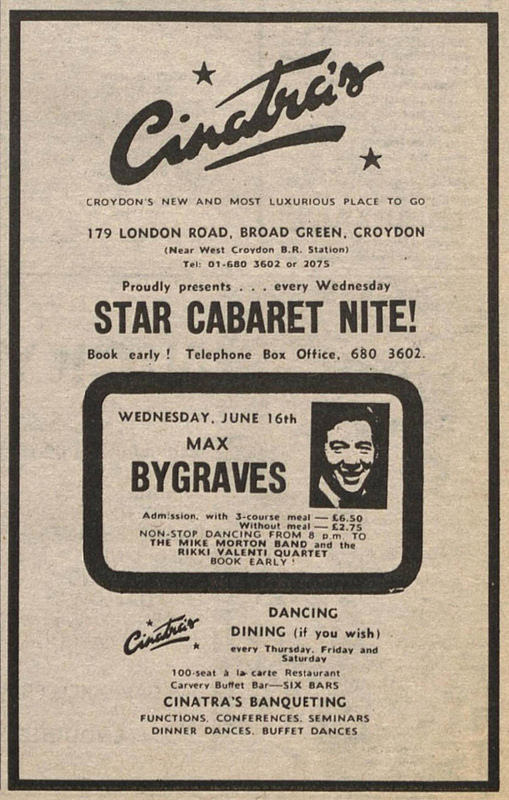
Billing itself as “Croydon’s new and most luxurious place to go”, Cinatra’s advertised a “Star Cabaret Nite!” every Wednesday, with stars including Max Bygraves, as well as a “100-seat à la carte Restaurant”, a “Carvery Buffet Bar”, and “Non-Stop Dancing”.[23]
Local resident Valerie Wakerell later recalled these early days in a letter to the Croydon Guardian:[24]
We would put on our glad rags [smart clothes] just to walk round and round the venue, perhaps showing off a new dress one had bought for that night, meeting up with old boyfriends who had perhaps dumped us in the week, giving them the impression we didn’t care — even though we were really broken hearted. It was the place to be — good innocent fun.
Others were less enamoured of the new club. One resident of the upper floors at Royal Mansions across the road wrote to Croydon Council in August 1976 complaining about its “flashing sign which creates a disturbance and a nuisance by constantly flashing directly into my lounge window”.[25]
Cinatra’s appears to have used only part of the nightclub space, as in early 1979 its owners opened another club, Watertown, in the same building. A report in The Stage magazine described this as a “sophisticated nightclub” offering “slick decor” and a “gourmet restaurant” to “the well dressed public”, with “selective entry” and “couples [...] preferred”. The management “hoped to present cabaret on at least a monthly basis”, and began this program with “the week-long engagement of Diana Dors”.[26]
1980s: “Unforgettable”
During the 1980s, Cinatra’s was the filming venue for television music show “Unforgettable”, produced by the club’s owners, Mike Morton and David Hadfield, under the name of Hadmor Productions. Performers included The Fortunes, PJ Proby, The Nashville Teens, and Billy Fury — the latter’s final public performance before his untimely death.[27] This decade also saw the opening of a second branch of Cinatra’s in a converted cinema in Clapham.[28]
Dave Brown, who worked in the local area from 1981 to 1985, attended four of the “Unforgettable” recording sessions on Tuesday evenings between February and August 1983:[29]
“Doors opened at 8.30 pm and filming didn't get underway until perhaps 10 pm with Alan Freeman & musicians. The music & applause was completely pre-recorded and artistes did their best to mime. Recording went on well into the night but I never managed to stay until the end as I had to get up early for work the next day.”
By 1991 Cinatra’s was hosting weddings, including that of Atul Narharibhai Patel and Bhavini Chandubhai Patel on 28 July 1991. Bride and groom were both of Gujarati descent; their wedding announcement in The Times included the information that her parents were “of Vaso and Thorntonheath [sic]” and his were “of Nadiad and Southall”.[30] It seems to have been a popular place to hold “massive Indian wedding parties” — in 1999, it was granted permission to increase its capacity to 1350 people, due to “regular requests to put on private parties for more than its usual limit of 1,200”.[31]
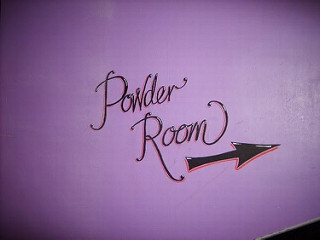
1990s–2000s: Strippers and sticky floors
Cinatra’s and Watertown both seem to have degenerated somewhat in their later years. Bygone Croydon commenter Kevin Arope recalled Cinatra’s as having a “sticky floor, disgusting buffet and porno red walls and furniture”, while on another Facebook group focused on reminiscences of Cinatra’s, Lynsey Horrigan commented: “I really remember the broken glasses all over the dancefloor and I often witnessed people necking their drinks and just slinging the glass — no joke!”[32]
By 1994, Cinatra’s was advertising a “ladies only hen night extravaganza” with “3 top male strippers”, and in 1998 “a series of disturbances” led to an attempt by the police to have its licence removed.[33] Watertown, as if to go one better, ran a monthly series of shows in 1999 offering “The ultimate in male flesh including UK’s most sensational strippers plus notorious sensational sex slaves” and “non stop X rated fun” — all for £22 per person (£35 in 2016 prices) including a “3 course dinner” and “free drinks all night”.[34]
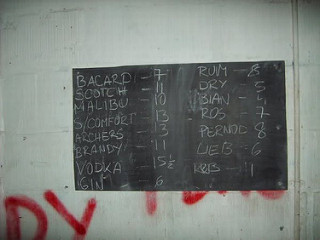
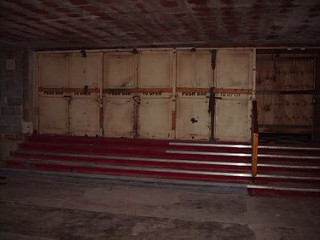
2004: Closure
Cinatra’s and Watertown both closed down for good in July 2004. There was no warning of the closure; when Lynn O’Neill turned up at Watertown for her pre-booked hen night on the evening of Saturday 31 July, she found not only “a big chain and a padlock on the door” but “another hen party outside all dressed up and a wedding party that were supposed to be having their reception there as well”.[36] Three days earlier, “more than 400 clubbers who each paid £8 in advance” (£11.27 in 2016 prices) had arrived for a drum and bass event at Cinatra’s only to find it had been cancelled.[37]
A spokesman for Cinatra’s management told the Croydon Advertiser that the closure was due to “a disagreement between the freeholder and the leaseholder”, and was “beyond our control”.[38] The premises have remained vacant ever since.[39]
Thanks to: Dave Brown; lesbub; Neil Barker; Nick Shepherd, Tony Skrzypczyk; the Planning Technical Support Team at Croydon Council; the staff, volunteers, and patrons at the Museum of Croydon; and my beta-readers Hessie, Kat, and Marsh-P. Census data and London phone books consulted via Ancestry.co.uk. Monetary conversions performed using the Bank of England inflation calculator (prices < £100 given to the nearest penny, prices from £100 to < £100,000 to the nearest pound, prices from £100,000 to < £1 million to the nearest £1,000, prices from £1 million to < £100 million to the nearest £100,000, prices ≥ £100 million to the nearest million).
Footnotes and references
- Gray’s 1851 lists John Keates,
Grocer and Tea-dealer, at 130 High Street, whereas the 1853 edition
instead has J Pelton “(late Keates)”, Grocer & Tea dealer. The 1861
census gives John’s age as 32, meaning he was born in 1828 or 1829
(later censuses also concur with this) and hence would have been aged
between 22 and 25 when he took over John Keates’ shop. John and
Sarah’s marriage, which took place on 7 July 1853 at St Pancras, was
announced on
page 7 of the 19 July 1853 Sussex Advertiser,
and is also recorded in the London, England, Church of England
Marriages and Banns, 1754-1921 online database (original data
from the Church of England Parish Registers, 1754-1921, at the London
Metropolitan Archives).
John and Sarah had three children, the oldest being John Ollis Pelton, who later published writing on the history of Croydon including Relics of Old Croydon and Memorials of Croydon Within the Crosses. According to the references given above for John and Sarah’s marriage, “Ollis” was Sarah’s maiden name. As well as his historical work, John Ollis Pelton served on Croydon Council for 32 years and as a Justice of the Peace for 26 years; he was an alderman and Chairman of the Libraries Committee. He died on 31 December 1938. (See his obituary on the front page of the 6 January 1939 Croydon Advertiser, “Losses to the Council” on page 7 of the 27 January 1939 Croydon Advertiser, and my photo of the memorial stone at Norbury Library, which bears John Ollis Pelton’s name among others.)
J Pelton (later John Pelton), grocer and tea dealer, is listed at 130 High Street in street directories from Gray’s 1853 to Gray & Warren’s 1859 inclusive; Richard Pelton, grocer and tea dealer, is listed in Gray & Warren’s 1861–62. Pelton Bros, Family Grocers (later Family Grocers and Wine Merchants) is listed at 129 and 130 High Street (and, in earlier directories, “at South Norwood” or at 2 South Norwood High Street as well) in directories from Simpson’s 1864 to Ward’s 1876 inclusive. Pelton Bros, Family Grocers and Wine Merchants, is listed at 128, 129, and 130 High Street (later renumbered to 40, 42, and 44) from Ward’s 1878 onwards. The 1881 census lists John as a “Grocer – Master — employing 17 men and 4 boys”; it also lists three live-in domestic servants at Shirley Lodge, the home he and Sarah shared with their daughter Alice.
John’s entry in the National Probate Calendar states that he was “of High-street, of the Whitgift stores George-street and of Chatfield house”. Ward’s directories list Whitgift Stores at 18 George Street from 1889 onwards. Note that Pelton Bros moved premises from 40–44 High Street to 7–11 High Street around 1894; see illustration in main article.
- Ward’s 1874 directory (preface pages lviii–lix) states that “Mr. J. Pelton” was a member of the Local Board of Health, elected in 1873 for Croydon Ward; it also lists “Mr. John Pelton” as a member of the Board’s Finance Committee and Water Committee. The 1876 edition (preface page xxxii) states that his term of office was to expire in 1877. He does not appear in the list of members of the Board in Ward’s 1880 or 1882. Ward’s 1884 directory (preface page xxxiii) lists Councillor Pelton as a Corporation of Croydon Town Council member for Central Ward and a member of the Corporation’s Finance Committee and its Legal and General Regulations Committee. He continues to be listed as a Central Ward Councillor in editions from 1885 to 1892 inclusive. From 1893 to 1896 inclusive, he instead appears as an Alderman for the South Ward. He’s listed as a Borough Justice in editions from 1887 to 1896 inclusive.
- John’s positions with the Croydon Permanent Building Society and Croydon Land and Investment Company are stated on page 20 of Urban Development and Redevelopment in Croydon 1835–1940, Ron Cox, PhD thesis, Leicester, 1970. No citation for this information is given, but his position with the former, at least, can be confirmed by a notice of issue of shares on page 4 of the 19 July 1879 Croydon Advertiser, which lists John Pelton of 130 High Street and Francis Warren of 131 High Street as the company’s auditors. See part 2 of my mini-series on the Zodiac Court site for more information on the Broad Green Estate sale.
- Quotation taken from an article by Sydney Edridge on the front page of the 11 July 1931 Croydon Times (“I Entertain the ‘Divine Sarah’”). See part 2 of my mini-series on the Zodiac Court site for more information on Levi Young. Ward’s 1893 directory, the data for which would have been finalised late the previous year, lists John Pelton, J.P., at Chatfield House.
- John’s date, place, and age of death are taken from his death announcement on the front page of the 28 April 1896Morning Post. Ward’s directories list John Pelton at Chatfield House from 1893 to 1896 inclusive, and Mrs Pelton from 1897 to 1899 inclusive. Sarah’s Oakfield Road address is taken from the 1901 census, and her date and place of death from her entry in the National Probate Calendar.
- Ward’s directories list Walter Paine [sic] at 103a London Road from 1900 to 1907 inclusive. Although they give the name “Telgu” or “Telugu” for the house, this is the same street number as Chatfield House previously had, and from placement in the listings it’s clear this is the same house. (103a was renumbered to 183 in 1927.) The 1901 census lists Walter, Agnes, and Greville at 103a London Road; Walter is described here as a “Gentleman” of “No Occupation”, but the 1891 census (at which point the family were living in Reading) has him as a “Brewer”, and the 1871 census (at which point Walter was as-yet unmarried and living with his mother and stepfather on Croydon High Street) has him as a “Brewer out of employ” (I can’t find him in the 1881 census). Although Dalton does not appear on London Road in the 1901 census, this is because he was away at school at Eastbourne; he was 16 years old at the time. Walter’s middle name is taken from the record of Dalton’s marriage on 27 June 1907 (Surrey, England, Church of England Marriages, 1754-1937, Ancestry.co.uk). All the abovementioned sources other than Ward’s directories give the family’s surname as “Pain” rather than “Paine”.
- Walter’s baptism record gives his parents’ names as John Brooks Pain and Harriet Pain, his date of baptism as 1 June 1847, his place of baptism as Nutfield, Surrey, and his parents’ residence as “Kentwins” [sic]. A small article in the November 1974 Nutfield Link newsletter states that “Henry VI granted a deed to William Kentwyne and in 1551 it came into the possession of the Clements family in whose hands it remained until about 10 years ago”. The record of Walter’s parents’ marriage on 21 September 1844 at Nutfield Parish Church shows that Harriet’s maiden name was Clement (Surrey, England, Church of England Marriages, 1754-1937, Ancestry.co.uk), and the “grandson (Dr Clement Paine) of the last Clements to live there” appears alongside Walter and Harriet in the 1871 census.
- As noted above, the 1871 census lists Walter as a “Brewer out of employ”, living at 30 High Street with his mother Harriet, brother Clement, and stepfather Frederick Page. Walter’s father had died either shortly before or shortly after his birth; according to burial and baptism records, John Brooks Pain was buried at All Souls, Kensal Green, on 4 February 1847, and Walter Julian Pain was baptised at Nutfield on 1 June 1847 (London, England, Church of England Deaths and Burials, 1813-1980, and Surrey, England, Church of England Baptisms, 1813-1912, both via Ancestry.co.uk). Quotation is taken from an advertisement on page 7 of the 15 February 1879 Reading Mercury (similar to the Berkshire Chronicle one reproduced here).
- As noted earlier, Ward’s directories list Walter Paine [sic] at 103a London Road from 1900 to 1907 inclusive, and the data for these directories was generally finalised late the previous year. The name “Telgu” is given from 1900 to 1906 inclusive, but corrected to “Telugu” in 1907. “Telugu” is also the spelling given in a notice on the front page of the 6 July 1907 Croydon Guardian, announcing that various items of furniture would be sold by auction at the house on 22 July.
- Ward’s directories list Robert Chas [Charles] Brown, physician and surgeon, at 87 London Road (later renumbered to 145) from 1904 to 1907 inclusive. He doesn’t appear in the alphabetical lists of principal residents or professionals/tradesmen prior to 1904.
- Following our Robert back through the censuses shows that his father was Preston-born James Taylor Brown (1871 census), and “Arthur Neville Brown: schoolmaster and variable star observer” by Jeremy Shears (an article on Robert’s brother Arthur) states that James Taylor Brown was the brother of the Preston surgeon Robert Charles Brown. Although our Robert was born in Suffolk, the family had moved back to Preston by the time of the 1871 census. His entry in the 1908 Medical Directory lists him as “BROWN, Robert Chas., jun.” — the use of “jun.” [junior] here again suggests a family connection. Further information on Sir Robert can be found in “Notable People of Present: Sir Robert Charles Brown 1836 – 1925” by Gillian A Lawson, archivist of the Preston Historical Society, and in his obituary on pages 1093–1094 of the 5 December 1925 British Medical Journal.
- Robert’s date and place of qualification are taken from his entry on page 408 of Alumni Cantabrigienses: A Biographical List of All Known Students, Graduates and Holders of Office at the University of Cambridge (1922) (viewed online via Google Books but also available at the Internet Archive). Dates of residence are taken from Ward’s directories. His date of death and address at death are taken from his entry in the National Probate Calendar, which also states that he died at “Dainton Coulsdon Surrey”; I haven’t been able to find out anything about the latter, but perhaps it was a friend or relative’s house, or a hospice.
- Ward’s directories list Valentine Wilkinson, M.B., B.C., F.R.C.S., at 103a (or its renumbering of 183 from 1928 onwards) London Road from 1925 until the final edition in 1939. London phone books list him here up to and including 1947; the sections for S–Z are missing in 1948 and 1949; and from 1950 onwards he instead appears at 239 Sydenham Road. His appointment as “certifying surgeon under the Factory and Workshops Acts [...] for the district of Croydon, which includes Croydon County Borough, Beddington and Wallington Urban District, Coulsdon and Purley Urban District, and part of Banstead Rural District (Woodmansterne Ward)” was accnounced in a small article on page 5 of the 8 May 1936 Surrey Mirror. Other information is taken from his biography in Plarr’s Lives of the Fellows Online at the Royal College of Surgeons website.
- Information and quotation taken from Chapter 14 (p268) of Royal London: The First 150 Years by Murray Ross. The author states that their information on United Friendly is taken from “K Kirkaldie, K B Parkerson, G A Qnatrill and G A Smith, The First 75 years — Service: An honour and a privilege (United Friendly Assurance, 1983)” and that “All the authors were former employees” (of Royal London). I unfortunately haven’t been able to track this source down myself.
- The January 1950 London phone book lists 30 branches of the company (as “United Friendly Insurance Co. Ltd”), and all except three are still present in the April 1952 edition, which is when the company first appears at 183 London Road. Its final phone book appearance is in the March 1964 Croydon edition. Quotation re 1939 is from page 269 of Royal London: The First 150 Years; this source also states that United Friendly merged with another insurance company, Refuge, in 1966 to form the United Assurance Group, and that United Assurance was then taken over by Royal London in 2000. For more information on the demolition of Chatfield House and Broad Green House, see part 3 of my article on Zodiac Court.
- Quotation and description of ballroom taken from “Plans to build massive Broad Green ballroom”, Croydon Advertiser, 29 November 1963, page 4.
- “Top Rank Croydon Suite” is listed at “London Road, Croydon” in phone books from the December 1966 North East Surrey edition onwards. (It’s absent from the June 1966 Croydon edition, which lists only Top Rank Home & Leisure Service Ltd at 44 High Street and Top Rank Ten Pin Bowling on Tamworth Road.) Information and quotation regarding the Reg Brooks band taken from an advert on page 13 of the 10 May 1968 Croydon Advertiser. Other information and quotations taken from “Top Rank Suite is to close”, Croydon Advertiser, 10 May 1974, front page.
- Via email, 10 February 2020.
- “Hundreds love the Love Affair”, Croydon Advertiser, 24 May 1968, front page. “Teeny bopper” description taken from the 45rpm.org.uk page on Love Affair.
- Information and quotations taken from “Top Rank Suite is to close”, Croydon Advertiser, 10 May 1974, front page.
- Quotations are taken from “Top Rank Options”, Croydon Advertiser, 10 May 1974, page 15. An advert on page 32 of the 10 June 1976 The Stage magazine (reproduced here) makes it clear that Cinatra’s was open by 16 June 1976.
- Quotation regarding “Non-Stop Dancing” taken from a photograph included in a planning application for “Erection of illuminated flashing sign” deposited on 12 July 1976 (ref A76/117). Other quotations taken from the previously-cited The Stage advert.
- “Starr attraction”, Croydon Guardian, 18 August 2004, page 24.
- Letter included in a planning application for “Erection of illuminated flashing sign” deposited on 12 July 1976 (ref A76/117).
- “Croydon’s Watertown club is named after Sinatra album”, The Stage, 3 May 1979, page 3. According to a photo in the collections at the Museum of Croydon (ref PH/06/550), the entrance to Watertown was at the right-hand side of the block of seven shops. (The entrance to Cinatra’s was at the left-hand side of this block.)
- According to an article on
page 3 of the 16 April 1981 The Stage magazine
(“Appeal court frees club to continue video shows”), as of that date
there was “a weekly music show ‘Unforgettables’ [sic] recorded at
Cinatra’s club for sale to the ITV network” by the club’s directors,
Mike Morton and David Hadfield, by their “video offshoot company”
Hadmor Productions, and said directors were planning “a second series
of 13 shows, which will be recorded at Cinatra’s with a live audience
and featuring stalwarts of the live music scene for the past two
decades.” A
YouTube clip from a 1983 episode suggests that later series were
broadcast on Channel 4. Information on Nashville Teens and PJ Proby
taken
from another
YouTube clip which includes the latter’s performance of
“Somewhere”. Information on The Fortunes taken
from yet another
YouTube clip. (I’ll be discussing another of PJ Proby’s Croydon
performances in a future article!)
David Hadfield seems to have also gone by the name David Heath-Hadfield, but I’m not sure when or under what circumstances he used each of these surnames.
Information on Billy Fury is taken from Halfway To Paradise: Britpop, 1955–1962 by Spencer Leigh and John Firminger, which is based on interviews with “over 100 musicians who were involved professionally between 1956 and 1963” as well as “many other personalities from the era”. Chapter 7, on Billy Fury, includes a quotation from Hal Carter, Billy’s manager: “Billy had a bad chest and on the Friday, he was supposed to cut the tracks for ‘Unforgettable’ on Channel 4. We rearranged it for the Monday and he whacked through six songs in a three hour session and we went for a meal. On Tuesday he was involved in the TV show itself: he put some ideas forward and he was over the moon that they were accepted. Up to that point, he had refused to do a TV special, — he didn’t think he looked good and so he didn’t want to be on TV, but even at that age, he was a super looking guy. After the TV show, everyone was applauding and asking for autographs and he felt good. We were in the limousine going back to town and he said, ‘Fix up a TV special. I’ll do it.’ [...] and then on Friday morning I got the bloody phone call and it was all over. [...] He was 43 and he knew he’d never collect his pension.” One of the songs Billy performed on Unforgettable was “Halfway To Paradise”; a clip of this is available on YouTube.
- Information on Clapham branch taken from its entry on the Cinema Treasures website. No sources are given, but it certainly doesn’t appear in pre-1985 London phone books, and according to an article on page 4 of the 2 June 1988 The Stage magazine, it was definitely open by mid-1988.
- Via email, 4 July 2019.
- “Marriages”, The Times, 29 July 1991, page 16.
- “Extra Guests”, Croydon Advertiser, 3 September 1999, p2.
- Bygone Croydon comment thread, 29 January 2013 (unfortunately now deleted, and I seem to have failed to archive it at the Internet Archive), and Cinatras— Who Remembers The Good Old Days? post, 24 August 2008. See also “Remember growing up in Croydon in the Nineties?”, Croydon Advertiser, 11 September 2015, page 25.
- Quotation re hen night taken from an advert on page 23 of the 25 March 1994 Croydon Advertiser (spotted by Dave Harwood). Information and quotation re disturbances taken from a brief article on page 2 of the 3 September 1999 Croydon Advertiser (“Extra guests”); I haven’t managed to find the original report of the licence removal request.
- Information and quotations taken from an advert on page 27 of the 10 September 1999 Croydon Advertiser.
- It’s not entirely clear what the numbers on the chalkboard mean. I initially thought they might be prices, but the relative numbers seem strange if that’s the case — vodka more than twice as expensive as gin? Martin Read suggests that they may instead be related to inventory tracking (online conversation, 1 October 2017).
- “Goodbye to a life of Cin”, Croydon Guardian, 11 August 2004, front page. Quotations are from Lynn’s daughter, Carla O’Neill, as quoted by the newspaper.
- “Final curtain for Cinatra’s?”, Croydon Advertiser, 13 August 2004, page 3.
- “Final curtain for Cinatra’s?”, Croydon Advertiser, 13 August 2004, page 3.
- Neil Barker tells me that the space has been empty since Cinatra’s departed (via email, 11 July 2017); it was certainly empty when an urban explorer from the 28 Days Later forum visited in February 2007.
